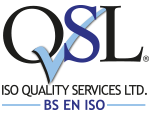Five ways ISO 45001 can reduce your H&S risks
19 Aug, 2019
Updated: April 2023
1.8 million working people suffer from a work-related illness, resulting in 36.8 million working days lost in 2021-2022*. ISO 45001 Occupational Health and Safety can help reduce your risks and safeguard the health of your stakeholders no matter what industry you work in. Here are five ways how:
1. Improving identification of hard-to-spot risks
ISO 45001 provides a structure for your risk assessments, helping you to anticipate a range of risks across different areas of your business. It also ensures that you review your risks regularly, ensuring that any changes, whether internal or external, are considered.
Richard Tresise from Cavendish Joinery, who implemented ISO 45001 alongside ISO 14001 Environmental commented on their experience, “The ‘straightening up procedure’ was not onerous; risk assessments are a case in point, we have always recognised our risks but the ISO 45001 standard requires that we carefully document the assessments and outcomes. Now, we ensure that meticulous records are kept which helps us achieve and retain our ISO certification and, in the unfortunate event of a Health & Safety incident, will also help us prove that we have taken action to protect our employees and visitors”. Find out more about Cavendish’s experiences of adding ISO 45001 to their existing ISO 9001 management system in our case study.
2. Predicting consequences
It’s not difficult to work out the consequences of having a wet floor with no warning signage or a machine with a broken guard but ISO 45001 helps ensure you think about the consequences of other, less obvious, risks like a pressurised work culture or long hours spent driving.
Of the 1.8 million work-related illnesses, over 900,000 of these related to work-related stress, depression, or anxiety*. The effects of the coronavirus pandemic were found to be a major factor to this, however this figure had already shown signs of increasing prior to the pandemic.
ISO 45001 can open your eyes to the real cost of ignoring risks. Whilst we all recognise that one person’s stressor could be the next person’s motivator, you need to take positive steps to protect your workforce against potential mental ill health caused or exacerbated by work. Mental health research conducted by Deloitte revealed that poor mental health costs UK employers up to £56 billion a year!
3. Improving your accident registers
Are your accident rates as low as your reporting indicates?
There’s no arguing with a RIDDOR normally, but are you capturing near misses? This is vital information which can help you put in place the right corrective actions. It’s helpful to remember that near misses are only a matter of luck, and these could have easily been accidents so why not treat them as such? We recommend you record your near misses, as you do accidents, as part of your ISO 45001 system.
4. Ensuring processes are documented
Having good practice in place is one thing. Having processes documented so everyone knows where to find them and can act consistently is another. If you have a growing business, it’s essential that you document your processes so your operations grow in a structured way.
Health and safety is everyone’s responsibility, not just that of your Health and Safety representatives. They are there to co-ordinate and improve compliance but to be successful, every member of the team needs to be aware of health and safety. By documenting and sharing procedures you set an expectation amongst your workforce that everyone has a part to play in making the organisation a safe place.
This approach has paid dividends for Linden Care Homes, who operate three different sites. As with all care homes, there is a very real risk to the care givers as well as to the vulnerable residents. Add in young families visiting residents and it’s a challenging health & safety environment. Linden have found the adoption of ISO 45001 drove shared processes across all three sites and has helped all employees to take a more proactive approach to H&S.
Understand how ISO supported Linden Care Homes in our case study.
5. Engaging your team
Pay rises and pool tables have the wow factor, but they can only go so far when it comes to employee engagement. Deloitte’s research also revealed that 28% of employees either left their jobs in 2021 or were planning to, 61% of which cited poor mental health as the reason. Today’s employees value knowing that their employers care about their welfare and take steps to protect it. Admittedly, with the cost of ill health caused or made worse by work costing employers billions, this isn’t entirely altruistic on the part of employers, but both parties clearly benefit.
Interested in implementing ISO 45001?
If you’re interested in learning more about ISO 45001 or would like a free, no obligation quote, contact our team of experts today on 0330 058 5551.
As a business, we have a real passion for business improvement and efficiency and can support you through the process from initial assessment to full certification in as little as six weeks. We take a flexible and practical approach to implementation and will continue to support you throughout your certification with twice yearly visits and ongoing account manager support. But don’t take our word for it, check out our latest Customer Satisfaction Report or Google Reviews to hear what our customers think.
* Statistic from the Health and Safety at Work Summary Statistics for Great Britain 2022
ISO Quality Services Ltd are proud to specialise in the implementation and certification of the Internationally recognised ISO and BS EN Management Standards.
Do you want to get ahead of your competition? Win more tenders or save time and money on reoccurring issues? Contact us today on 0330 058 5551 or email info@isoqsltd.com.
Alternatively, you can request a quote by filling out our enquiry form and a member of our team will be in touch shortly.

